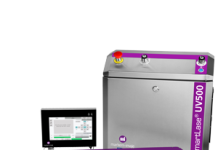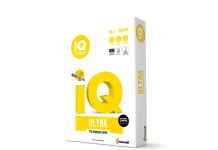The HERMA InNo-Liner system with sensor control for variable labelling heights will be available from October 2020.
HERMA grabbed a lot of attention last year with its linerless labeling system, which was recognised as the first of its kind to cater for the strict requirements imposed by shipping labels. Now for the first time, the self-adhesive solutions specialist is demonstrating its ability to apply labels to the top of shipping cases of different heights that are fed to the applicator in any sequence.
Thanks to a new app and augmented reality, anyone can now see the system in action by projecting it virtually into their own operating environment on a smartphone or tablet. The InNo-Liner AR app can be downloaded free for Apple and Android devices.
‘The variable labelling height was the final development stage leading to the start of series production,’ said Martin Kühl, who heads HERMA’s Labeling Machines Division. ‘It was accomplished with the help of the knowledge we have gained from the first test runs together with customers.’
These projects entailed deployment of the HERMA InNo-Liner system with units designed for side labelling. According to Kühl, ‘Even this configuration gave us compelling evidence that the system is capable of operating at the speeds and with the process reliability demanded by logistics centres.’ The production model now being launched transfers the initially non-sticky label to a tamp pad, which is equipped with a box height sensor and a linear unit.
First, a water-only activation unit performs a transverse motion underneath the label, where it activates the adhesive with a highly consistent spray of micro-atomised water. Then the linear transfer unit automatically moves the tamp pad, with the activated label, to the required labelling height for the next case in the line. The desired effect – extremely high adhesion of the labels – arises from perfect interaction of the activation unit with the patented multi-layer adhesive 82S.
HERMA engaged all three of its divisions, Self-adhesive Materials, Labels and Labelling Machines, in developing the InNo-Liner system. ‘Pooling our expertise has been and remains essential to the success of this project,’ said HERMA managing director Dr. Thomas Baumgärtner.
The activation medium used by the InNo-Liner system for the adhesive, which is not at all sticky at first, is demineralised water – water in its purest form. ‘It ensures consistently high process quality, irrespective of the natural water hardness fluctuations encountered at different operating sites,’ explained Dr. Baumgärtner. Water consumption is minimal, especially since any unused water is filtered and recycled in the system. The activation unit can be cleaned as required, but necessary manual intervention consists largely of renewing label reels. For printing variable data on the labels, both thermal transfer and direct thermal options are available. Labels can also be preprinted in colour with conventional techniques.
‘The underlying principle is easy to understand and simple. It does not involve any solvents, heat or other activation media associated with possibly undesirable side-effects. In addition, the cost is much the same as that of a conventional self-adhesive label. At the same time, the demand for genuinely sustainable packaging solutions is steadily gathering momentum,’ said Dr. Baumgärtner.
Developed for shipping labels, the HERMA InNo-Liner system removes thousands of tons of siliconised paper liner from the market and the waste disposal chain. ‘This is a winning argument with regards to enhanced sustainability,’ Dr. Baumgärtner continued, ‘especially in view of the anticipated growth in global parcel shipping volume.’ Experts expect the quantity of shipped boxes to almost double by 2025, when it is forecast to reach a total of around 200 billion units worldwide.
[sc name=”submit-news” ]
[sc name=”whatsapp_subscribe” ]





















